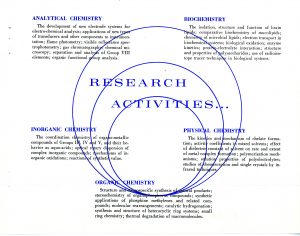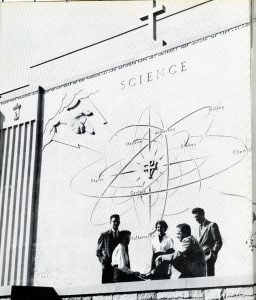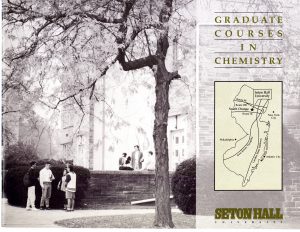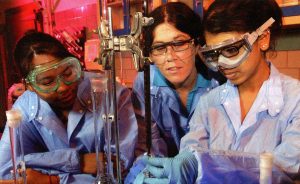Seton Hall has traditionally been noted for its detailed liberal arts curriculum but has also hosted a number of other major programs across the academic spectrum. Within the natural sciences, the field of Chemistry has been an integral part of the educational offerings for the student body. This year marks the 160th anniversary of the first documented course offered at Seton Hall College eventually led to increased expansion to a full-fledged program known as the Department of Chemistry and Biochemistry at the present time.

The study of Chemistry by general definition found in various primers definition chain of qualities involved with this natural science focuses primarily on the investigation of the properties and behavior connected to matter. This includes the deeper study of elements and compounds involving the reactive behavior of atoms, ions, and molecules in particular.
During the first years of Seton Hall on the South Orange campus, the Chemistry class option was listed within the earliest Seton Hall College Catalog(ue)s/Bulletins under the “Mathematical Course” banner was by all indicators a required course. Between the 1860s-90s, an introductory Chemistry class was offered to enrolled students during the First Term of the Sophomore year at the school and held on Tuesdays, Fridays, and Saturdays during a particular semester. The first text-books used included popular works for their time: “First Principles of Chemistry, For the Use of Colleges and Schools,” by Benjamin Silliman (Philadelphia: T. Bliss & Co., 1866) and later, A Class-Book of Chemistry: On the Basis of the New System, by Edward Livingston Youmans (New York: Appleton, 1857) as foundational works to this discipline.

Moving into the twentieth century, a more specific insight to Chemistry and its place in the Setonia curriculum can be gleaned from the following description of study from the pages of the Seton Hall College Catalogue of 1921-22. This passage from one hundred years ago provides a detailed look at what was involved in the requirements associated with class participation at that time . . .
“SCIENCE. CHEMISTRY – The aims of the course are: (1) to offer all students an opportunity to become acquainted with the facts of modern chemistry and the special forms of reasoning and method applied to those practical sciences which have their basis in chemistry; (2) to fill out the general training of undergraduates; and (3) to prepare the student for later advanced work in the sciences. Special stress is therefore laid on thoroughness of preparation, and the symmetrical development of the student’s knowledge. The elements of inorganic chemistry are taught by lectures, laboratory illustrations nad experiments, and recitations from notes and from a general text-book. Through the scope of the course is essentially fitted to the purposes in view, yet the method of treatment, particularly in the matter of lecture presentation, offers many special advantages to the student. He must learn how to synopsize and generalize a lecture, he must know how to trace its drift and link its lessons with the matter already learned, ad must see its import, as well, in relation to the work yet to be done. The notebook counts for examination results, and a pass-mark cannot be won without it. The course occupies the entire Sophomore year. Its study is obligatory on all B Sc. degree students and for such others as can offer for it no satisfactory equivalent . . . The following is a brief outline of the course: Oxygen; hydrogen; water and hydrogen dioxide; the atomic theory; molecular and atomic wights; chemical calculations; nitrogen; the atmosphere; solutions; acids; bases; salts; neutralization; valence; compounds of nitrogen; sulphur and its compounds; the periodic law; the chlorine group. Carbon and its simpler compounds; flames the phosphorus group; silicon; titanium; baron; the metals; the alkaline-earth group; copper; mercury; silver; tin and lead; manganese; gold and the platinum group; some simpler organic compounds.”

Moving forward over the last several decades, scores of Setonia students have either majored in Chemistry or taken a version as an elective or in some other context. Among the lasting testament to this study are lasting course descriptions, papers, and other landmarks across campus. This includes McNulty Hall (now known as the Science Center) featuring the legendary “Atom Wall” relief built during the 1950s has been the host to countless lectures and lab experiments by faculty and students alike to further the knowledge of Chemistry-centered inquiry.

A continuum of supporting the need and advance of those wishing to explore advanced study expanded in large measure when Chemistry became the first University-wide doctoral program established by University during the mid-1960s. A number of Master’s Theses were produced by 1964 and the first PhD degrees earned that year led to published Dissertations released the following year. Specific examples can be found within the Seton Hall University Libraries Catalog by searching via the following link – https://library.shu.edu/library/books within the search term: “Chemistry” and choosing to search within the category of: “Thesis, Dissertation” resources and focusing upon a specific year or year-range.
Renovations to the Science Center, publications arising from Chemistry faculty, and other developments in the new Millennium have provided a success story for those connected to the study and success of this field of endeavor. In documenting the trajectory and evolution of the history within the holdings found at the Monsignor William Noé Field Archives & Special Collections Center there are various resources including various articles in school publications, vertical file content, prospectus booklets, departmental notes along with various faculty notes, and a specific historical textbook collection that shows examples of college-level print aids published mainly from the 1920s-70s. Our Rare Book holdings also contain centuries-old titles and have been consulted by the Seton Hall community over the years including some of the oldest titles found in our catalog . . .
Lewis, William. The Edinburgh new dispensatory: containing, I. The elements of pharmaceutical chemistry. II. The materia medica … III. The pharmaceutical preparations and medicinal compositions of the latest editions of the London and Edinburgh pharmacopoeias … Being an improvement of the New dispensatory by Dr. Lewis. (Edinburgh: William Creeck, 1797) [Seton Hall University Libraries, ARCHIVES & SPECIAL COLLECTIONS Rare Book Library – IN-ARCHIVES USE ONLY, RS151.3 .L4 1797]
Stack, Richard. Introduction to the study of chemistry; explaining its principles, and their application to arts, manufactures, etc. … (Dublin: Graisberry & Campbell, 1802) [Seton Hall University Libraries, ARCHIVES & SPECIAL COLLECTIONS MacManus Irish – IN-ARCHIVES USE ONLY, QD28 .S78]
Buffon, Georges Louis Leclerc, et al. Histoire naturelle, générale et particulière : avec la description du cabinet du roy. (Paris: De l’Imprimerie, 1803-04) [Seton Hall University Libraries, ARCHIVES & SPECIAL COLLECTIONS Rare Book Library – IN-ARCHIVES USE ONLY]
Brande, William Thomas, et. al. A manual of chemistry: containing the principal facts of the science, arranged in the order in which they are discussed and illustrated in the lectures at the Royal Institution of Great Britain. (New York: George Long, 1821) [Seton Hall University Libraries, ARCHIVES & SPECIAL COLLECTIONS Rare Book Library, QD30 .B82]

Historical Text-Books and Rare Book classified Chemistry works can be found by limiting your search to “Archives and Special Collections” when locating the following site – https://library.shu.edu/library/books Additional resources both historical and contemporary can be found by searching for wider Chemistry resources via the University Libraries Homepage – https://library.shu.edu/home and Chemistry-based Library Guide constructed by Dr. Lisa Rose-Wiles found here – https://library.shu.edu/chemistry

For more specific information on Chemistry and Natural Science-centered resources and any other aspect of University History and/or Rare Books we are glad to assist your research efforts. Contact us at: archives@shu.edu or by phone at: (973) 275-2378.
